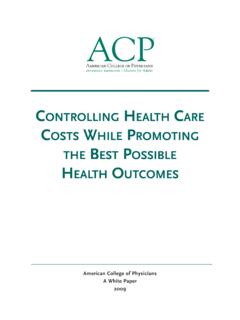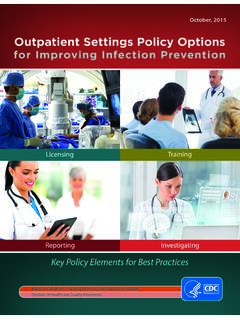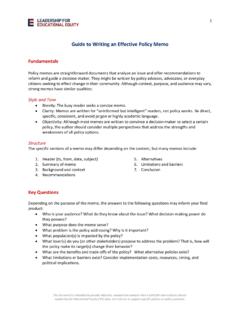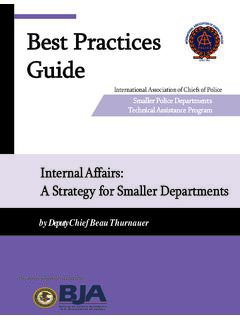Transcription of BEST BUYS’ AND OTHER RECOMMENDED INTERVENTIONS …
1 best BUYS AND OTHER RECOMMENDED INTERVENTIONS FOR THE PREVENTION AND CONTROL OF NONCOMMUNICABLE DISEASESUPDATED (2017) APPENDIX 3 OF THE GLOBAL ACTION PLAN FOR THE PREVENTION AND CONTROL OF NONCOMMUNICABLE DISEASES 2013-20202 WHAT IS IN THIS DOCUMENT?This document provides policymakers with a list of best buys and OTHER RECOMMENDED INTERVENTIONS to address noncommunicable diseases (NCDs) based on an update of Appendix 3 of the Global Action Plan for the Prevention and Control of NCDs 2013 2020. A list of options is presented for each of the four key risk factors for NCDs (tobacco, harmful use of alcohol, unhealthy diet and physical inactivity) and for four disease areas (cardiovascular diseases, diabetes, cancer and chronic respiratory diseases).
2 Mortality and morbidity from NCDs constitutes one of the major challenges for development in the 21st century. Around 40 million people die annually as a result of NCDs, including 15 million people who die too young between the ages of 30 and 69. The burden continues to rise disproportionately in low- and lower middle-income countries while in all countries, these deaths disproportionally affect the poorest and most vulnerable. The majority of premature NCD deaths in this 30 69 age group are the result of the four main noncommunicable diseases: cardiovascular diseases, cancer, diabetes and chronic respiratory May 2013 the World Health Assembly endorsed WHO s Global Action Plan for the Prevention and Control of NCDs 2013 2020.
3 The global action plan has six objectives whose implementation at country level will support the attainment of the nine NCD targets by 2025, as well as facilitate the realisation of Sustainable Development Goal 3 Good Health and Well-being. Part of this plan comprises a menu of policy options and cost-effective and RECOMMENDED INTERVENTIONS ( Appendix 3 ) to assist Member States, as appropriate for their national context, in implementing measures towards achieving the Sustainable Development Goals (SDG) Target best BUYS AND OTHER RECOMMENDED INTERVENTIONSS ince the global action plan was endorsed in 2013, Appendix 3 has been updated to take into consideration the emergence of new evidence of cost-effectiveness and the issuance of new WHO recommendations that show evidence of effective INTERVENTIONS .
4 The updated Appendix 31 (which reflects changes to objectives 3 and 4 only) was endorsed in May 2017 by the Seventieth World Health Assembly. Renamed best buys and OTHER RECOMMENDED INTERVENTIONS , this updated Appendix 3 comprises a total of 88 INTERVENTIONS , including overarching/enabling policy actions, the most cost effective INTERVENTIONS , and OTHER RECOMMENDED INTERVENTIONS . These 88 INTERVENTIONS are presented in tables, with one table showing the relevant options for each of the four key risk factors and four NCDs addressed. 1 Officially called the updated Appendix 3 of the WHO Global NCD Action Plan 2013-2020. WERE THESE INTERVENTIONS SELECTED? INTERVENTIONS in Appendix 3 were updated taking into consideration the emergence of new evidence of cost-effectiveness or new WHO recommendations since the adoption of the Global Action Plan in 2013.
5 The formulation of some of the INTERVENTIONS was also refined based on lessons learnt from the use of the first version of Appendix transparent, unified approach for the identifications was taken after the first consultation on updating Appendix 3, 2015 1. From the consultation, the following effectiveness criteria were used for identifying INTERVENTIONS : >An intervention must have a demonstrated and quantifiable effect size, from at least one published study in a peer reviewed journal >An intervention must have a clear link to one of the global NCD targets Using the above criteria, additional INTERVENTIONS were considered. The intervention list for the updated Appendix 3 comprises INTERVENTIONS which have been unchanged from the original version, INTERVENTIONS which have been re-worded or revised to reflect updates in WHO policy or scientific evidence and new were assessed for cost effectiveness, feasibility, as well as non-financial considerations.
6 INTERVENTIONS which were assessed for cost-effectiveness by the WHO CHOICE model are listed for each of the risk factors and disease areas. As mentioned, the 16 INTERVENTIONS considered to be the most cost-effective and feasible for implementation were those with an average cost-effectiveness ratio of I$ 100/DALY 2 averted in low and lower middle-income countries. INTERVENTIONS with an average cost-effectiveness > I$ 100 are listed next and may be considered as per the country context. INTERVENTIONS that are mentioned in WHO s guidelines and technical documents where WHO-CHOICE analysis could not be conducted are also listed in the tables under WHO-CHOICE analysis not available . Care needs to be taken when interpreting these lists; for example, the absence of WHO-CHOICE analysis does not necessarily mean that an intervention is not cost-effective, affordable or feasible rather, there were methodological or capacity reasons for which the WHO-CHOICE analysis could not be completed at the current time.
7 For more information on the methodology please see the technical THE IMPORTANCE OF NON-FINANCIAL CONSIDERATIONSCost-effectiveness analysis is a useful tool but it has limitations and should not be used as the sole basis for decision-making. When selecting INTERVENTIONS for the prevention and control of NCDs, consideration should be given to effectiveness, cost-effectiveness, affordability, implementation capacity, feasibility, according to national circumstances, and impact on health equity of INTERVENTIONS , and to the need to implement a combination of population-wide policy INTERVENTIONS and individual non-financial considerations that may affect the feasibility of certain INTERVENTIONS in some settings are shown as a footnote to each relevant intervention.
8 1 2 The International dollar is a hypothetical unit of currency that has the same purchasing power parity that the dollar had in the United States at a given point in COUNTRIES CAN USE THIS INFORMATIONC ountries can select from the list of best buys and OTHER RECOMMENDED INTERVENTIONS , based on their national context. Consideration for selection of INTERVENTIONS could include (i) which INTERVENTIONS will bring the highest return on investment in national responses to the overall implementation of the 2030 Agenda for Sustainable Development; (ii) priority government sectors that need to be engaged (in particular health, trade, commerce and finance) and (iii) concrete coordinated sectoral commitments based on co-benefits for inclusion in national SDG responses.
9 The economic analyses in the technical annex, upon which this list is based, give an assessment of cost-effectiveness ratios, health impact and the economic cost of implementation. These economic results present a set of parameters for consideration by Member States, but such global analyses can be accompanied by analyses in the local context. OTHER tools, such as the One Health Tools are available to help individual countries cost specific INTERVENTIONS in their national context. When considering INTERVENTIONS for the prevention and control of noncommunicable diseases, emphasis should be given to both economic and non-economic criteria, as both will affect the implementation and impact of INTERVENTIONS .
10 Non-economic implementation considerations such as health impact, acceptability, sustainability, scalability, equity, ethics, multisectoral actions, training needs, suitability of existing facilities and monitoring are essential elements in preparing to achieve the targets of the global action plan and should be considered before the decision to implement the items shown in these WHO Secretariat will explore options to provide an interactive web-tool, to enable users to compare and rank the information according to their own needs. The detailed description of the WHO-CHOICE1 methods for these analyses, including the assumptions, strength of evidence and the individual studies used to inform the development of models for each intervention, will be published separately as peer-reviewed scientific papers, which will be publicly available through open The International dollar is a hypothetical unit of currency that has the same purchasing power parity that the dollar had in the United States at a given point in time.
















